
Let us begin at the beginning, in a time before we even had mobile phones (if you can remember that far back): a time of minerals, meteorites, fossils and…dinosaurs.
These items grace Rooms 1 to 10 on the lower, mezzanine floor of the Natural History Museum.
- Extraordinary collection of precious minerals
- …especially the bouquet of gemstones
- Huge meteorite collection
- Dinosaurs!
- Excellent displays on the evolution of cultures and modern humans
- Some items may vary dependent on exhibitions and improvements
- See also:
Minerals and more
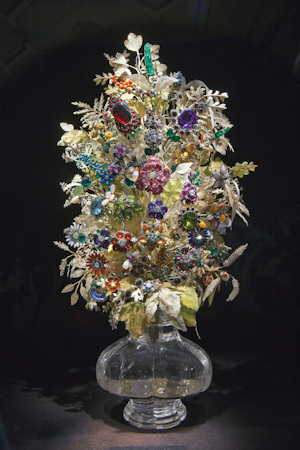
(The gemstone bouquet; photo courtesy of and © Naturhistorisches Museum Wien)
Those with geological interests need only know that galleries 1-4 house one of the world’s great scientific collections of minerals.
Those without geological interests (and let’s be honest, there are one or two of us) should still pay attention, because some hidden joys lie among these exhibits.
Don’t be misled by the initial displays: the further you go on this floor, the more English you’ll find and the more infotainment in the form of videos, buttons to press, and similar.
So, what are the highlights from the perspective of the casual visitor?
In Gallery 1, the wall you pass through to enter the room has a display of different building materials which you might easily gloss over, but shouldn’t.
They reveal exactly what was used to construct some of Vienna’s most famous buildings (like the cathedral, the opera house and the Naturhistorisches Museum itself), but also include samples from such iconic locations as the Vatican, Versailles, the Paris opera house, and Westminster cathedral.
I’m not a mineral fan, but there’s a strange kind of fascination to seeing the array of natural colours and the depth of the collection across the opening galleries.
I once checked just one small cabinet, for example, and found minerals from Yugoslavia, Switzerland, Nepal, the USA, Norway, Malawi, Vietnam, the USSR, Canada, Nigeria, Madagascar, Ethiopia, France, Italy, Brazil, Germany, Sweden, Pakistan and (of course) Austria.
A global collection indeed.
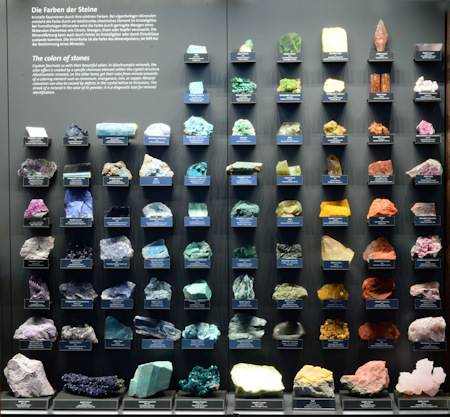
(Part of the geological display; press photo © NHM Wien, Alice Schumacher)
And everywhere a reminder of history. One giant slab of rock salt, for example, previously made an appearance at the 1873 world exhibition in Vienna.
The recently refurbished Gallery 4 has the gemstones and precious metals: opals, diamonds, topazes etc. Here you also find a cabinet with some remarkable photoluminescent minerals, which light up like a Jackson Pollock painting.
Be sure to look at the opposite wall with the exit to Gallery 5. There you find giant emeralds and other gemstones, not to mention precious metals. For example:
- A 17g diamond (a typical diamond in a ring weighs 0.2g)
- An opal weighing over half a kilo
- An 826g gold nugget
- A 6.2kg nugget of platinum
One gold nugget turns out to be a present from Nicholas I of Russia to Emperor Ferdinand 1 in 1836. It certainly beats a bunch of flowers and a box of chocolates. Though talking of flowers…
Empress Maria Theresa did present her husband with a rather unusual bouquet in 1764. Look closely to see it even has insects on the blooms.
This particular bunch of flowers does have one tiny difference to your traditional florist’s arrangement: everything is made of precious gems, including pearls, sapphires and over 2,000 diamonds.
A little expensive for most budgets, but at least you never have to worry about keeping the water topped up in the vase.
Meteorites and fossils
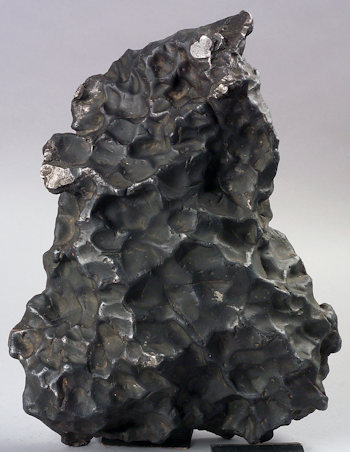
(The Hraschina meteorite; press photo © NHM Wien, A. Schumacher)
Gallery 5 houses the world’s largest publically-accessible meterorite collection, featuring some 1,100 items. The International Commission on Geoheritage ranks the NHM’s collection as one of the world’s most important.
An almost 300kg monster from 1866 greets you as you enter, and recent acquisitions include one half of the Galb Inal lunar meteorite. Look, too, for the 1751 Hraschina meteorite that kicked off the collection.
I made the mistake of viewing the impact simulator, which happened to pick a spot for a meteorite “landing” near my apartment (with inevitable consequences).
Galleries 6 and 7 then cover topics like the origins of the earth and life, biodiversity, and climate change – all with English translations…and use the fossil record to trace evolution.
You’ll notice how the museum successfully integrates modern presentations and information with the old cabinets. If you have small kids, for example, tell them to keep their eyes open in Gallery 7 with its little peek-a-boo windows down at toddler eye level.
Now, fossilised amphibian footprints are fine and dandy, but let’s be honest, we’ve all seen Jurassic Park, so…
The dinosaurs
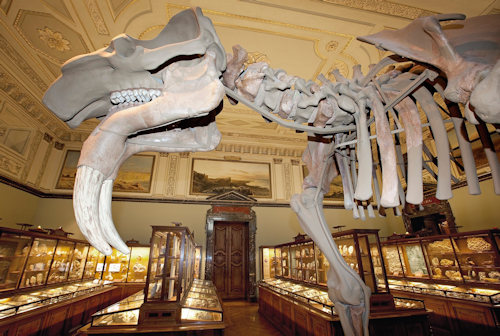
(One of many dinosaurs; press photo © Naturhistorisches Museum Wien)
Galleries 8 to 10 are the ones you’ve been waiting for. Among the highlights:
- A near complete fossil of a Mesohippus and Euoohippus, both forerunners of the modern horse
- Full-scale models of a Pteranodon in flight and a Paraphysornis brasiliensis (otherwise known as a Terror Bird)
- The lower jaw of a Deinotherium. Lower jaw might sound uninspiring, until you realise how much dental floss you’d need to keep those mighty tusks in shape
- Skeletons of a Diplodocus, Iguanadon and similar, and the most inappropriately named dinosaur, Allosaurus fragilis. There’s nothing fragile about this T-Rex lookalike, as the impressive animatronic model of a youngster demonstrates.
- As a special bonus to get the kids giggling: fossilised dinosaur poo
- A genuine Sauropod bone you may actually touch. It’s around 140-150 million years old
Before you leave the dinosaur area, take the time to check the exit that returns you direct to the entrance hall. The display of gold jewellery dates back as far as the 4th millennium BC; the gold discs of Stollhof are the second oldest gold items ever found in the world.
Prehistoric section
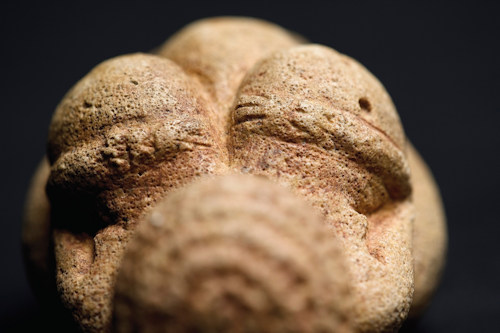
(The Venus von Willendorf; press photo courtesy of and © Naturhistorisches Museum Wien)
Galleries 11 to 13 feature modern bilingual displays dealing with the evolution of cultures and modern man.
The area begins with the obligatory pottery, tools, jewellery, and similar. Pop into the side room in Gallery 11, though, to find the famous Venus of Willendorf figurine.
The Venus figure is actually one of the oldest human statues in the world, dating back over 29,000 years. Her neighbour, “Fanny” or the “figurine from Stratzing”, is 36,000 years old.
Just to put that in perspective, someone sculpted dear Fanny over 30,000 years before anyone had the bright idea to arrange some big rocks in a circle at a place called Stonehenge.
Gallery 12 features extensive reconstructions of the salt mines in Hallstatt. Whatever your views on prehistoric salt mines, it’s frankly amazing what scientists can actually reconstruct from a few scratches on a wall and some bone remnants.
For example, analysis of these bones reveals who did what work (hint: women were not banned to the kitchen). Researchers know what parasites gave the average mine worker an unfortunate itch and can even suggest the kind of leaves likely used as toilet paper.
A couple of highlights from the rest of the galleries on this floor:
- A copy of the 996 AD document that carries the first mention of the word, Austria (“Ostarrichi”), issued by Emperor Otto III
- A video installation that projects your image on a wall, allowing you to see yourself wearing 3000 years of human fashions
- The inconspicuous cubicle and screen in Gallery 15, which takes your photo, then transforms it into your choice of an early human lookalike
- A model of an Australopithecus males, bearing an uncanny resemblance to me toward the end of a lockdown
Once you’re done, it’s time to go up to the zoological collections.